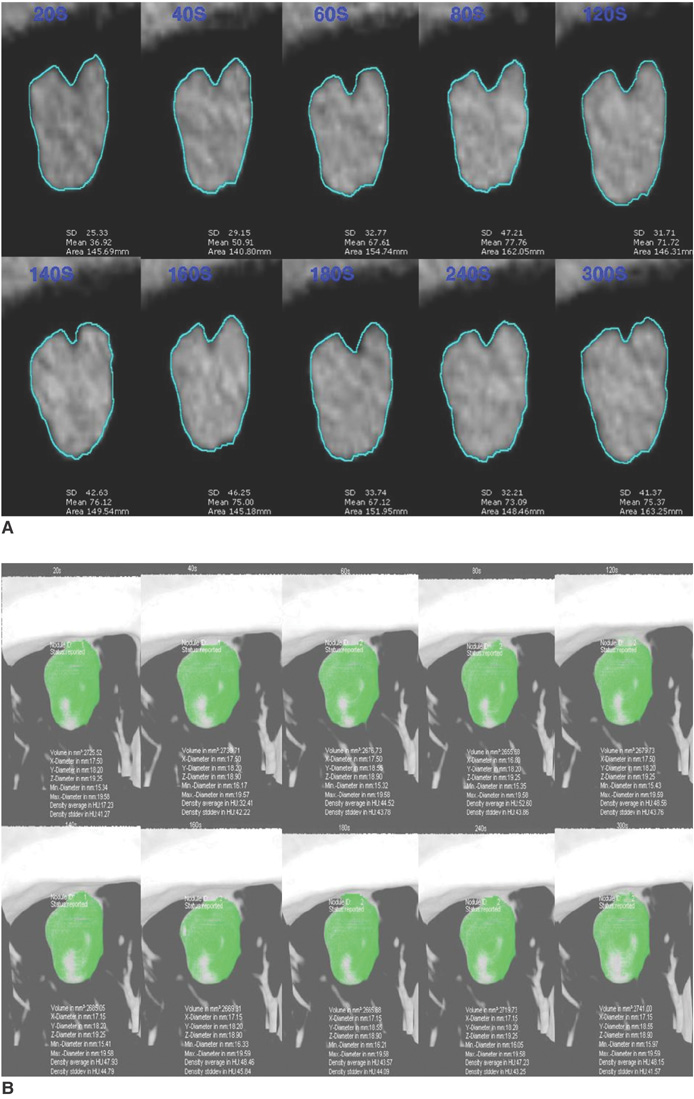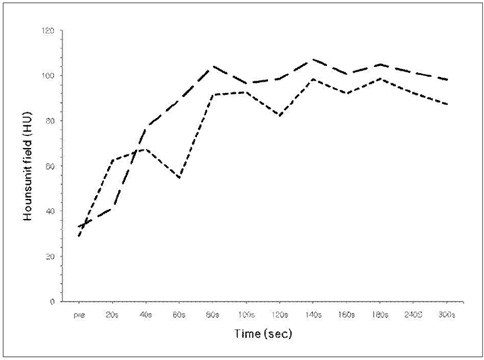Korean J Radiol.
2008 Oct;9(5):401-408. 10.3348/kjr.2008.9.5.401.
Solitary Pulmonary Nodule on Helical Dynamic CT Scans: Analysis of the Enhancement Patterns Using a Computer-Aided Diagnosis (CAD) System
- Affiliations
-
- 1Department of Radiology, Chonbuk National University Hospital and Medical School, Research Institute for Medical Science, Chonbuk, Korea. gyjin@chonbuk.ac.kr
- 2Department of Province, Chonbuk National University Hospital and Medical School, Research Institute for Medical Science, Chonbuk, Korea.
- KMID: 1385397
- DOI: http://doi.org/10.3348/kjr.2008.9.5.401
Abstract
OBJECTIVE
We wanted to investigate the usefulness of a computer-aided diagnosis (CAD) system in assisting radiologists to diagnosis malignant solitary pulmonary nodules (SPNs), as compared with diagnosing SPNs with using direct personal drawing. MATERIALS AND METHODS: Forty patients with SPNs were analyzed. After the pre-contrast scan was performed, an additional ten series of post-contrast images were obtained at 20-second intervals. Two investigators measured the attenuation values of the SPNs: a radiologist who drew the regions of interest (ROIs), and a technician who used a CAD system. The Bland and Altman plots were used to compare the net enhancement between a CAD system and direct personal drawing. The diagnostic characteristics of the malignant SPNs were calculated by considering the CAD and direct personal drawing and with using Fisher's exact test. RESULTS: On the Bland and Altman plot, the net enhancement difference between the CAD system and direct personal drawing was not significant (within +/- 2 standard deriation). The sensitivity, specificity, positive predictive value (PPV), negative predictive value (NPV) and accuracy of diagnosing malignant SPNs using CAD was 92%, 85%, 75%, 96% and 88%, respectively. The sensitivity, specificity, PPV, NPV and accuracy of diagnosing malignant SPNs using direct drawing was 92%, 89%, 79%, 92% and 88%, respectively. CONCLUSION: The CAD system was a useful tool for diagnosing malignant SPNs.
MeSH Terms
-
Adult
Aged
Contrast Media
Diagnosis, Computer-Assisted/*methods
Diagnosis, Differential
Female
Humans
Iohexol/analogs & derivatives/diagnostic use
Lung Neoplasms/*radiography
Male
Middle Aged
Predictive Value of Tests
Radiographic Image Enhancement/*methods
Retrospective Studies
Sensitivity and Specificity
Solitary Pulmonary Nodule/*radiography
Tomography, Spiral Computed/*methods
Figure
Reference
-
1. Jeong YJ, Yi CA, Lee KS. Solitary pulmonary nodules: detection, characterization, and guidance for further diagnostic workup and treatment. AJR Am J Roentgenol. 2007. 188:57–68.2. Leef JL 3rd, Klein JS. The solitary pulmonary nodule. Radiol Clin North Am. 2002. 40:123–143.3. Shaham D, Guralnik L. The solitary pulmonary nodule: radiologic considerations. Semin Ultrasound CT MR. 2000. 21:97–115.4. Tan BB, Flaherty KR, Kazerooni EA, Iannettoni MD. The solitary pulmonary nodule. Chest. 2003. 123:S89–S96.5. Tang AW, Moss HA, Robertson RJ. The solitary pulmonary nodule. Eur J Radiol. 2003. 45:69–77.6. Wang MP, Tan YQ, Zhang GZ, Zhang JG, Wu H, Yang JY. Differential diagnosis of benign and malignant solitary pulmonary nodule with computer-aided detection. Zhongguo Yi Xue Ke Xue Yuan Xue Bao. 2006. 28:64–67.7. Erasmus JJ, Connolly JE, McAdams HP, Roggli VL. Solitary pulmonary nodules: Part I. Morphologic evaluation for differentiation of benign and malignant lesions. Radiographics. 2000. 20:43–58.8. Marten K, Grabbe E. The challenge of the solitary pulmonary nodule: diagnostic assessment with multislice spiral CT. Clin Imaging. 2003. 27:156–161.9. Yankelevitz DF, Henschke CI. Small solitary pulmonary nodules. Radiol Clin North Am. 2000. 38:471–478.10. Yi CA, Lee KS, Kim BT, Choi JY, Kwon OJ, Kim H, et al. Tissue characterization of solitary pulmonary nodule: comparative study between helical dynamic CT and integrated PET/CT. J Nucl Med. 2006. 47:443–450.11. Trotman-Dickenson B, Baumert B. Multidetector-row CT of the solitary pulmonary nodule. Semin Roentgenol. 2003. 38:158–167.12. Das M, Mühlenbruch G, Mahnken AH, Flohr TG, Gündel L, Stanzel S, et al. Solitary pulmonary nodule: effect of two computer-aided detection systems on radiologist performance. Radiology. 2006. 241:564–571.13. Muhm JR, McCullough AE. The enhancing rim: a new sign of a benign pulmonary nodule. Mayo Clin Proc. 2003. 78:1092–1096.14. Swensen SJ, Viggiano RW, Midthun DE, Müller NL, Sherrick A, Yamashita K, et al. Lung nodule enhancement at CT: multicenter study. Radiology. 2000. 214:73–80.15. Jeong YJ, Lee KS, Jeong SY, Chung MJ, Shim SS, Kim H, et al. Solitary pulmonary nodule: characterization with combined wash-in and washout features at dynamic multi-detector row CT. Radiology. 2005. 237:675–683.16. Schaefer JF, Vollmar J, Schick F, Vonthein R, Seemann MD, Aebert H, et al. Solitary pulmonary nodules: dynamic contrast-enhanced MR imaging-perfusion differences in malignant and benign lesions. Radiology. 2004. 232:544–553.17. Yi CA, Lee KS, Kim EA, Han J, Kim H, Kwon OJ, et al. Solitary pulmonary nodules: dynamic enhanced multi-detector row CT study and comparison with vascular endothelial growth factor and microvessel density. Radiology. 2004. 233:191–199.18. Shah SK, McNitt-Gray MF, Rogers SR, Goldin JG, Suh RD, Sayre JW, et al. Computer aided characterization of the solitary pulmonary nodule using volumetric and contrast enhancement features. Acad Radiol. 2005. 12:1310–1319.19. Shah SK, McNitt-Gray MF, Rogers SR, Goldin JG, Suh RD, Sayre JW, et al. Computer-aided diagnosis of the solitary pulmonary nodule. Acad Radiol. 2005. 12:570–575.20. Mori K, Niki N, Kondo T, Kamiyama Y, Kodama T, Kawada Y, et al. Development of a novel computer-aided diagnosis system for automatic discrimination of malignant from benign solitary pulmonary nodules on thin-section dynamic computed tomography. J Comput Assist Tomogr. 2005. 29:215–222.21. Lee JW, Goo JM, Lee HJ, Kim JH, Kim S, Kim YT. The potential contribution of a computer-aided detection system for lung nodule detection in multidetector row computed tomography. Invest Radiol. 2004. 39:649–655.22. Kim KG, Goo JM, Kim JH, Lee HJ, Min BG, Bae KT, et al. Computer-aided diagnosis of localized ground-glass opacity in the lung at CT: initial experience. Radiology. 2005. 237:657–661.23. Goo JM, Lee JW, Lee HJ, Kim S, Kim JH, Im JG. Automated lung nodule detection at low-dose CT: preliminary experience. Korean J Radiol. 2003. 4:211–216.24. Rubin GD, Lyo JK, Paik DS, Sherbondy AJ, Chow LC, Leung AN, et al. Pulmonary nodules on multi-detector row CT scans: performance comparison of radiologists and computer-aided detection. Radiology. 2005. 234:274–283.25. Verdun FR, Gutierrez D, Schnyder P, Aroua A, Bochud F, Gudinchet F. CT dose optimization when changing to CT multi-detector row technology. Curr Probl Diagn Radiol. 2007. 36:176–184.26. Bland JM, Altman DG. Statistics methods of assessing agreement between two methods of clinical measurement. Lancet. 1986. 1:307–310.27. McNitt-Gray MF. AAPM/RSNA physics tutorial for residents: topics in CT. Radiation dose in CT. Radiographics. 2002. 22:1541–1553.
- Full Text Links
- Actions
-
Cited
- CITED
-
- Close
- Share
- Similar articles
-
- A Computer-Aided Diagnosis for Evaluating Lung Nodules on Chest CT: the Current Status and Perspective
- Computer-Aided Differential Diagnosis of the Pulmonary Nodule: Towards an Understanding of the Medical Imaging Basics and Experiences in the Field
- Studies and Real-World Experience Regarding the Clinical Application of Artificial Intelligence Software for Lung Nodule Detection
- Malignant Solitary Pulmonary Nodule: Enhancement Patterns on Contrast-enhanced Dynamic CT with the Histopathologic Evaluation
- The Role of Dynamic CT for the Differential Diagnosis of Solitary Pulmonary Nodule





